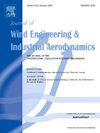Evaluation of wind-induced fragility and cumulative fatigue damage on seismically isolated high-rise building
IF 4.2
2区 工程技术
Q1 ENGINEERING, CIVIL
Journal of Wind Engineering and Industrial Aerodynamics
Pub Date : 2024-10-13
DOI:10.1016/j.jweia.2024.105915
引用次数: 0
Abstract
Seismically isolated buildings (SIBs) are built higher and higher for which wind-induced effect is of worldwide concern. To comprehensively study this effect, this paper proposes a theoretical framework of wind-induced fragility evaluation for SIBs. A Chinese seismically isolated high-rise engineering building is systematically evaluated as a case study. The probability wind load demand model for SIBs is developed. The wind-induced performance evaluation indices set according to different national codes are assessed and compared from a probabilistic perspective. A parametric analysis is conducted to explore a reasonable range of values for wind load partial factor. The cumulative fatigue damage at seismic isolation interface (SII) under extreme wind loads is investigated. Results show that SIB can generally meet performance requirements for lateral stiffness. The performance evaluation indices under 1-year return period wind load are more demanding than those under 10-year return period wind load. The value of wind load partial factor is recommended to be within the range of 1.4–1.6 for sufficient wind-resistance stability without compromising seismic reduction performance. The LRB used in SII not only provides wind-resistance stability, but also perform well in resisting wind-induced fatigue damage. Nevertheless, periodic inspections are necessary to assess wind-induced residual deformation at SII.
隔震高层建筑风致脆性和累积疲劳损伤评估
隔震建筑(SIB)越建越高,其风致效应受到全世界的关注。为了全面研究这种效应,本文提出了风致隔震建筑脆性评估的理论框架。本文以中国某高层隔震工程建筑为例,对其进行了系统评估。建立了 SIB 的概率风荷载需求模型。从概率角度评估和比较了根据不同国家规范设定的风致性能评估指标。通过参数分析,探讨了风荷载部分系数的合理取值范围。研究了极端风荷载下隔震界面(SII)的累积疲劳损伤。结果表明,隔震界面一般能满足侧向刚度的性能要求。1 年重现期风荷载下的性能评估指标比 10 年重现期风荷载下的指标要求更高。建议风荷载局部系数取值在 1.4-1.6 范围内,以获得足够的抗风稳定性,同时不影响减震性能。新加坡第二期工程采用的轻轨不仅具有抗风稳定性,而且在抗风引起的疲劳破坏方面也表现出色。不过,有必要进行定期检查,以评估风引起的残余变形。
本文章由计算机程序翻译,如有差异,请以英文原文为准。
求助全文
约1分钟内获得全文
求助全文
来源期刊
CiteScore
8.90
自引率
22.90%
发文量
306
审稿时长
4.4 months
期刊介绍:
The objective of the journal is to provide a means for the publication and interchange of information, on an international basis, on all those aspects of wind engineering that are included in the activities of the International Association for Wind Engineering http://www.iawe.org/. These are: social and economic impact of wind effects; wind characteristics and structure, local wind environments, wind loads and structural response, diffusion, pollutant dispersion and matter transport, wind effects on building heat loss and ventilation, wind effects on transport systems, aerodynamic aspects of wind energy generation, and codification of wind effects.
Papers on these subjects describing full-scale measurements, wind-tunnel simulation studies, computational or theoretical methods are published, as well as papers dealing with the development of techniques and apparatus for wind engineering experiments.

 求助内容:
求助内容: 应助结果提醒方式:
应助结果提醒方式:


